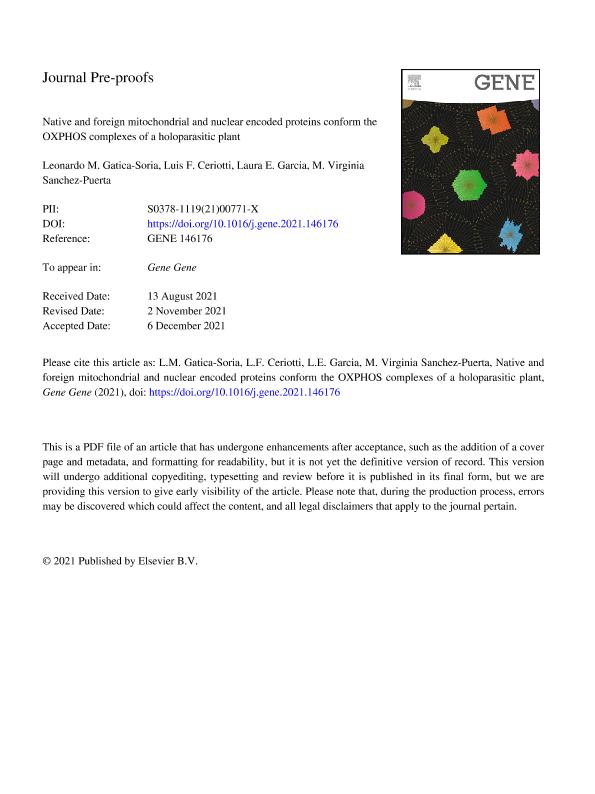Artículo
Native and foreign mitochondrial and nuclear encoded proteins conform the OXPHOS complexes of a holoparasitic plant
Gatica Soria, Leonardo Martin ; Ceriotti, Luis Federico
; Ceriotti, Luis Federico ; Garcia, Laura Evangelina
; Garcia, Laura Evangelina ; Sánchez Puerta, María Virginia
; Sánchez Puerta, María Virginia
 ; Ceriotti, Luis Federico
; Ceriotti, Luis Federico ; Garcia, Laura Evangelina
; Garcia, Laura Evangelina ; Sánchez Puerta, María Virginia
; Sánchez Puerta, María Virginia
Fecha de publicación:
04/2022
Editorial:
Elsevier Science
Revista:
Gene
ISSN:
0378-1119
Idioma:
Inglés
Tipo de recurso:
Artículo publicado
Clasificación temática:
Resumen
The intimate contact between the holoparasitic plant Lophophytum mirabile (Balanophoraceae) and its host plant (Fabaceae) facilitates the exchange of genetic information, increasing the frequency of horizontal gene transfer (HGT). Lophophytum stands out because it acquired a large number of mitochondrial genes (greater than 20) from its legume host that replaced the majority of the native homologs. These foreign genes code for proteins that form multisubunit enzyme complexes, such as those in the oxidative phosphorylation system (OXPHOS) and cytochrome c maturation (ccm) system, together with dozens of nuclear-encoded subunits. However, the existence and the origin of the nuclear subunits that form the major part of the OXPHOS and ccm system in Lophophytum remain unknown. It was proposed that nuclear-encoding genes whose products interact with foreign mitochondrial proteins are also foreign, minimizing the incompatibilities that could arise in the assembly and functioning of these multiprotein complexes. We identified a nearly complete set of OXPHOS and ccm system subunits evolving under selective constraints in the transcriptome of Lophophytum, indicating that OXPHOS is functional and resembles that of free-living angiosperms. Maximum Likelihood phylogenetic analyses revealed a single case of HGT in the nuclear genes, which results in mosaic OXPHOS and ccm system in Lophophytum. These observations raise new questions about the evolution and physiology of this parasitic plant. A putative case of cooperation between two foreign (one mitochondrial and one nuclear) genes is presented.
Archivos asociados
Licencia
Identificadores
Colecciones
Articulos(IBAM)
Articulos de INST.DE BIOLOGIA AGRICOLA DE MENDOZA
Articulos de INST.DE BIOLOGIA AGRICOLA DE MENDOZA
Citación
Gatica Soria, Leonardo Martin; Ceriotti, Luis Federico; Garcia, Laura Evangelina; Sánchez Puerta, María Virginia; Native and foreign mitochondrial and nuclear encoded proteins conform the OXPHOS complexes of a holoparasitic plant; Elsevier Science; Gene; 817; 4-2022; 1-10
Compartir
Altmétricas



